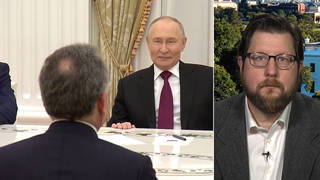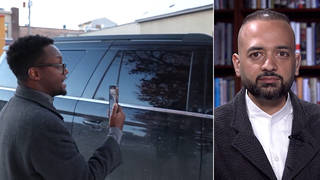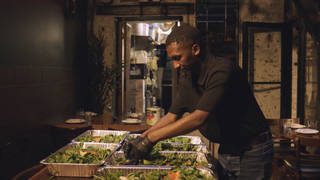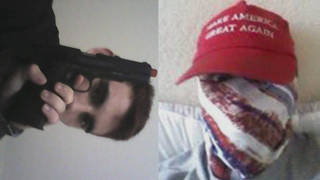
As the Jacksonville community mourns the loss of three people killed Saturday in a racist shooting, more details are emerging about the white supremacist who went to a Dollar General store looking to target Black people before killing himself. Authorities say he left behind a suicide note and other writings outlining his racist ideology. The 21-year-old gunman had legally bought the two weapons he used in the shooting, including an AR-15-style rifle marked with swastikas. The shooting occurred as thousands gathered in Washington, D.C., on Saturday to mark the 60th anniversary of the March on Washington and Martin Luther King Jr.'s “I Have a Dream” speech. Activists in Jacksonville had also been preparing commemorations of Ax Handle Saturday, when a white mob led by the Ku Klux Klan violently attacked Black civil rights protesters on August 27, 1960. “This hurricane of racism that we've been dealing with in the Jacksonville community is not new,” says Jacksonville-based historian and civil rights leader Rodney Hurst, who helped lead desegregation protests in the city during the 1960s.
Transcript
AMY GOODMAN: This is Democracy Now!, democracynow.org, The War and Peace Report. I’m Amy Goodman, with Juan González.
Vigils in Jacksonville, Florida, are continuing after a white supremacist gunman shot and killed three Black people at a dollar store on Saturday. The gunman, who had a swastika on his AR-15-style gun, attacked a dollar store in a predominantly Black neighborhood after being turned away from the campus of Edward Waters University, an HBCU, a historically Black college. The gunman shot himself dead after the rampage. Jacksonville Sheriff T.K. Waters spoke to reporters.
SHERIFF T.K. WATERS: Our community is grappling to understand why this atrocity occurred. I urge us all not to look for sense in a senseless act of violence. There’s no reason or explanation that will ever account for the shooter’s decisions and actions. His sickening ideology is not representative of the values of this Jacksonville community that we all love so much. We are not a community of hate. We stand united with the good and decent people of this city.
AMY GOODMAN: Saturday’s shooting occurred at the same time thousands were gathering in Washington, D.C., to mark the 60th anniversary of the March on Washington, when Dr. Martin Luther King gave his “I Have a Dream” speech. The Jacksonville shooting also occurred as civil rights activists in Jacksonville were preparing to remember the 63rd anniversary of Ax Handle Saturday. On August 27, 1960, a white mob led by the Ku Klux Klan violently attacked Black protesters who were engaged in peaceful sit-ins in Jacksonville. We’re going to play a piece about that in a moment.
But right now we’re joined now by two guests: Rodney Hurst, civil rights leader from Jacksonville, as well as a historian and the award-winning author of several books, former president of the NAACP Youth Council in Jacksonville that helped lead the sit-in protests in Jacksonville in 1960; we’re also joined by Democratic Congressmember Maxwell Alejandro Frost of Florida, the first Afro-Cuban American and first member of Generation Z to serve in Congress. Frost is the former national organizing director for March for Our Lives, which was formed by survivors of the Parkland shooting in Florida.
From the Parkland shooting to what we saw in Jacksonville, let’s begin with Rodney Hurst. Our condolences to your whole community, three dead, this so familiar, as we saw what happened in Buffalo at the Tops grocery store. Can you talk about how people are responding and what they’re demanding right now in Jacksonville? And thanks so much for joining us, as Jacksonville looks like it’s in the target of the storm, the hurricane that’s making its way up from Cuba.
RODNEY HURST: Yeah, an honor to be with you. Yeah, we are in another hurricane, that will come through Jacksonville later this week.
But this hurricane of racism that we’ve been dealing with in the Jacksonville community is not new. It’s almost as if it’s a recurring-type circumstance. Jacksonville’s community, obviously, is outraged. The Black community is outraged. There was a prayer vigil. The governor showed up at the prayer vigil. He was booed by a number of Black folk who were there, because his rhetoric, the jargon that has dribbled out of his mouth, has set the tempo, the tenor, the atmosphere for the kinds of racism and the core racist attitudes that we have seen that has plowed the ground for the fertility of what is happening in this country right now. They have taken — “they” being the DeSantises, the Donald Trumps of this country — have taken conversations from private sources, private insides, to public, and some of the things they used to whisper, they are saying publicly.
The other problem that I think that we need to deal with is that there is a silence in the white Christian community. We don’t see the outrage with what has happened with white folk here in Jacksonville. There are some, obviously, and so this won’t be a broad brush. But you need to feel that outrage.
But what happens is that when you’re dealing with a circumstance, and in his country, where Black folk, from the founding of this country, have been so disrespected and insulted because they were considered nothing more than property, then it’s very easy to see that what happens to us is something, “Oh, well, it’s them and not us,” and then people go on about their business. But that is not how the way you govern. That is not how the way you develop a community and bring people together.
JUAN GONZÁLEZ: And, Rodney Hurst, could you talk about the — back in 1960, your involvement in the civil rights movement, the attack that you suffered on what’s called Ax Handle Saturday, after dozens of white people attacked you and other peaceful protesters at a lunch counter with ax handles and baseball bats? And how far do you think Jacksonville has come in these past 70 so years?
AMY GOODMAN: Actually, Rodney Hurst, before you lay it out here, we’d like to give some credit to your grandson-in-law, who did an amazing short doc, where he brings us the video footage and you describing what happened, called Unless We Tell It, the video directed by Kyle Dorrell, featuring you, Rodney Hurst, who served as the president of the NAACP Youth Council in Jacksonville, which organized those sit-ins in 1960. Let’s go to a clip of that, in response to Juan’s question.
RODNEY HURST: So, during the summer, we sat in at all the lunch counters in downtown Jacksonville. The first one was Woolworth’s. And we had more than 85 young people that day. Some of the seats were — people were sitting in them, but every vacant seat, we sat in. And the white waitress said to us, “You can’t sit here. This is for white people. The colored lunch counter is at the back of the store.” And we said, “We want to be served.” “Well, we don’t serve Negroes here. You can be served in the back.”
So, the manager came out. His name was James Word. And he read a card. And after he read us the card, he closed the lunch counter. So, then whites stood behind us yelling the racial epithets — “jungle bunny,” “[bleep],” “[bleep] ain’t acting like colored people for the NAACP.” So we always sat longer than lunchtime, because we figured that they serve fresh lunches. There were no microwaves, no convection ovens. So if you wanted your racism, we wanted to make it as expensive as possible, so we sat longer than the lunchtime.
We saw no police the entire time. We later found out that police were there in plainclothes because they were taking pictures of all of us. You would think the slogan “to protect and serve” would mean something. It did not mean anything when it came to those of us who were sitting in. As we have seen in sit-in demonstrations — Jim Clark, Bull Connor — they did not care about your age. They cared less than a tinker’s damn about who you were, male or female, young or old. If your skin was Black, then whatever you got, you deserved it.
The end of that week was August 27th. Mr. Pearson got a call from — he never did tell us who he got the call from, but got a call saying, and his word to us was there were “some strange goings-on” at Hemming Park. So, when he got down to Hemming Park, there were white males in Confederate uniforms handing out ax handles. So, when we had our meeting that morning at the Laura Street Presbyterian Church Youth Center, Mr. Pearson told us — he told us what was going on. And Mr. Pearson’s words were: “Something could happen today.”
We proceeded anyway. It was healthy fear, but it was determined courage. And we sat in. We did not go to Woolworth’s that day. We went to Grant’s, which was on the corner of Adams and Main. And again, they closed the lunch counter.
So, as we walked out of Grant’s and turned west on Adams Street, I got this panorama. I saw a guy up on top of a truck with his camera. And I heard the commotion and saw people in the distance running down Adams Street, and couldn’t quite visualize what was happening. Then I saw the guy on top of the truck with the camera knocked off of the truck by somebody swinging something. And in a short period of time, we realized this was a mob, and they were coming for us. Stores there on Adams Street started locking their doors. Our only option was to run to get out of danger.
I ran down Main Street. Somebody picked me up and took me to the Laura Street Presbyterian Church Youth Center. And slowly, members of the Youth Council started coming back, crying. The rumors started flying: Somebody got killed, somebody got beat up.
Two patrolmen from the sheriff’s department showed up. They said they wanted to talk to us. But the pastor was there, Wilbert Miller. Reverend Miller, who was the pastor of the Presbyterian Church, was about 5’7”. And Reverend Miller, looking up at the patrolman, from 5’7” to 6’1” or whatever the guy was, saying, “You will not set foot on church property.” And they didn’t.
ON-SCREEN TEXT: Jacksonville, Florida, Mayor Haydon Burns publicly stated the horrific events of that day never happened.
RODNEY HURST: We had a press conference at the home of a Black doctor, Dr. James Henderson. He was a dentist. And from there, we planned a mass meeting at St. Paul AME Church at the corner of 13th and Myrtle.
We had also heard that the Klan was going to march in the Black community that night. So there were Blacks sitting inside their cars with guns and rifles in case the Klan decided they wanted to come down Myrtle Avenue.
We had reporters from all over the country. St. Paul AME Church looked like an international press conference. So, we announced the boycott, and the Times-Union announced the boycott of downtown Jacksonville.
ON-SCREEN TEXT: Over the next several months a strategic plan was put into place, by an unofficial biracial committee to integrate the downtown lunch counters.
RODNEY HURST: But we went down to Woolworth’s five days in a row to the white lunch counter, and Marjorie and I ate at the white lunch counter for five days in a row. And after those five days, all of the lunch counters in downtown Jacksonville were integrated.
The civil rights movement has always been about “we” and “us,” not “me” and “I.” So, everything we were able to do, we were able to do it for those folk who look like us. And as long as we are fighting racism and fighting for Black human dignity and respect, the struggle continues, and the struggle is not in vain.
AMY GOODMAN: A short documentary about Ax Handle Saturday called _Unless We Tell It, directed by Kyle Dorrell, featuring our guest, Rodney Hurst, who served as president of the NAACP Youth Council in Jacksonville, which organized those sit-ins in 1960. In fact, Rodney Hurst, it was August 27th when you were remembering that 63 years ago, Saturday —
RODNEY HURST: Yes.
AMY GOODMAN: — when the shooting took place.
RODNEY HURST: Yeah, the shooting was on Saturday. The actual day date, or the date of the month, was Sunday, which was the actual 63rd commemoration that we had. We’ve been having those commemorations over the years.
In 1960, when sit-ins began in Greensboro, North Carolina, by four students from North Carolina A&T, most of the sit-inners were college students. In Jacksonville, most of us were high school students, motivated not only to understand who we were in Black history, but to join the Youth Council NAACP by my eighth grade American history teacher, whose name was Rutledge Pearson, when I was 11 years old. I started school when I was 5, and I got skipped. So, as my pastor would say, favor ain’t fair. But I joined the Youth Council NAACP at 11, and I became president at 15 and led the sit-ins at 16. But 95%-plus of the young people who sat in in Jacksonville were high school students. Mr. Pearson had a slogan that he would say to us: “Freedom is not free. If you’re not a part of the solution, then you’re a part of the problem.” And we wanted to be a part of the solution.












Media Options